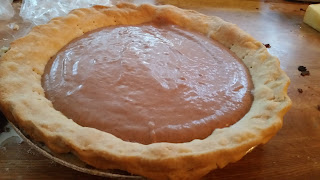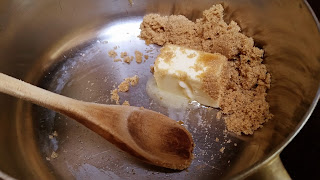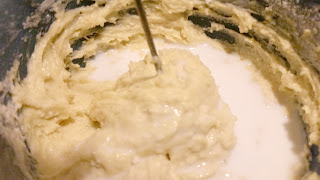Happy day after Thanksgiving! We at A Book of Cookrye had a wonderful time, and hope you did too.
 |
| This year's Thanksgiving brought to you by the makers of tinfoil. |
This year, among many other pies we made, we were especially pleased to make this one because it looked so,
so good.
Great-Grandma P's Butterscotch Pie
3 tbsp butter
1 c brown sugar
3 scalded milk
½ c flour
1 egg yolk
½ cold milk
1 tsp vanilla
1 baked pie shell or graham cracker crust
First, scald the milk by pouring the 3 cups into a pan and place on the stove at medium or medium–low heat. You will need to stir this the entire time so it does not scorch. You are looking for those tiny bubbles that form just before it boils. Do not let it boil because it will ruin the consistency. When those million tiny bubbles form around the edges of the pan (while you are still whisking) take off the burner immediately and set it down to cool. It must cool about 10 minutes before you start the rest.
Melt the butter in a different saucepan. Once it is melted, add in the brown sugar and stir and stir until the sugar has melted and is liquid like. This will take a long time. You will think this is pointless, and that the sugar is going to stay solid no matter what you do to it on the stove. Keep going, stirring constantly and scraping the pot as you go, and it will eventually melt.
Add the scalded milk and incorporate well leaving the heat at medium low. The sugar will be insanely hot, and if you just dump the milk in at once, you will lose all of it in a burst of steam while the sugar all cools down on the spot into shards that never dissolve again. What you want to do is start stirring the sugar really fast, being sure to get both the edges of the pot and the middle of it moving. Then add a splash of milk without slowing down your spoon. Be ready for a lot of steam. Thoroughly stir the sugar for a few seconds and add another splash in the same way. Be sure to scrape the edge of the pot each time. Add the rest of the milk in the same way- after enough has been added, the filling will be thin enough that you can just dump the rest of it in.
Meantime, in a small bowl mix flour, egg yolks, and the cold milk together into a smooth paste – get all those little lumps out or the pudding will be lumpy! Take the pot off the burner so it doesn't scorch while you're doing this.*
Gradually add the mixture to the saucepan, stirring constantly. Once the pudding has thickened, cook for a few minutes more and then take off the stove and add the vanilla.
Now, if you have lumps, don’t worry – just use a fine mesh strainer on top of a clean bowl and strain the pudding through! Works every time. Or, put it all through a blender.
Press plastic wrap down on the surface, being sure it makes contact with the pudding. This will prevent a skin forming. Then, leave it to cool.
When it's cooled off, stir it to see if there are any lumps you didn't notice when it was hot. If there are lumps and you don't feel like hearing people whine about them, just use a blender. Then, pour the pudding into the pie crust. Refrigerate until you serve it.
You can either eat it plain, grab a tub of Cool Whip and spread it around or, you can make some homemade whipped cream to put on top.
It won't really set to slicing consistency, so A Book of Cookrye recommends doing as Kelli's Kitchen did- put it in individual pie shells instead of a big one.
*If you're better at planning ahead than I am, you might make the flour paste before starting anything else (or while you were waiting 10 minutes for the scalded milk to cool off), so it's ready when you need it.
|
I'd thought this recipe looked divoon ever since the
first Pieathlon- and had been meaning to make it for some time. You know how whatever your interest is, you always have some project you've been meaning to get around to? Carpenters have plans waiting to be made, painters have sketches and ideas they keep intending to turn into a finished picture, and we at A Book of Cookrye have recipes that we've been meaning to actually get out and make. And so, we decided to make it for Thanksgiving this year! An aunt and uncle graciously agreed to watch the dog while we were gone all day, and so a pie was in order to leave at their house with her.
We took issue with the first instruction after scalding the milk. You see, we read in one of the cookbooks Our Mom of Cookrye had when she bravely gave us a kitchen education that in order to make butterscotch taste like butterscotch, you have to melt the two
together. Otherwise, whatever you create will just taste like buttery brown sugar- which is good, but it's not quite butterscotch. I forget what cookbook it was, but whoever wrote it was almost religious in their insistence on the subject. However, although this goes against what some cookbook writer bashed into my head about butterscotch, this isn't some random recipe fished out of a book. This is from someone's great-grandmother who must have known what she was doing. Therefore, we decided to trust the recipe and see what happened.
 |
| If this doesn't work, I will be sad. |
Not five minutes into making this, we at A Book of Cookrye were wondering why we let this recipe sit unmade for so long.
Already the kitchen smelled tantalizing and amazing. However, we once again doubted Great-Grandma P's recipe. Every other butterscotch thing we've made, the butter and sugar mix to make some kind of oozy sludge of sweet divinity. This, however, was barely enough melted butter to make the sugar damp.
An inordinate amount of time passed, and the brown sugar clumps went from slightly damp to dried out and tooth-breakingly hard. The recipe clearly said the contents of the pot should be melting, and they were going in exactly the wrong direction. We were about to just move on with the recipe and hope the sugar rocks dissolved in the milk if we stirred it long enough. However, when we stopped stirring to pick up the pot of scalded-and-cooled milk, what should we see but... this!
It's hard to see in the above picture, but if you look closely, you can see some of the sugar looks kind of wet, just to the right of the center. Realizing we should
always have faith in great-grandmotherly recipes, we put the pot of milk back down and kept stirring as the brown sugar melted surprisingly fast.
See the puddles starting to form? This made us once again stare at the pot, asking a question that comes up so often in the kitchen:
We had such passionately conflicting feelings over this pot of brown stuff. On the one hand, the kitchen smelled heavenly. The brown sugar had melted into this lovely, velvety-looking stuff that proved we should always have faith in people's great-grandmothers' recipes. On the other hand, the butter slick covering the whole mess made us fear that this would be a really greasy pie.
However, we decided that we had already gotten this far without the recipe telling us a single lie. If we could melt a bunch of dried-out brown sugar rocks into a beautifully smooth sauce, surely we could turn it into a pie that wouldn't make anyone ask "Why all the butter?" And so, we started to pour in the milk that had been waiting on the stove, and suddenly the pot of velvety smooth butterscotch goodness turned into a saucepan of angry spatters and hissing steam.
 |
| That milk is definitely scalded now. |
It turns out that cooking something for a long time over a hot stove will make it
really fricken hot. I've actually seen recipes like this before, and there's a trick to actually getting this to work. If you add all of the liquid to your way-hotter-than-boiling pot of sugar stuff, you'll have sugar shards floating in it that never dissolve. Instead, you have to beat the crap out of the pot's contents while adding the liquid in tiny splashes. If your spoon has a short handle, you may well burn your arm. This pie was one of the last ones we got around to making and therefore we were getting really tired, but nearly scalding a forearm is a great way to snap out of sleepiness.
Eventually, the sugar stuff stops putting up a steam fight, leaving the milk ready to easily stir in. By this point, you may possibly have also saved a lot of money on waxing your arms.
Now that we had successfully added the milk to the pot of superheated sugar sludge with only minor burns, we sampled the pot of stuff and..... yes. If you were to ask how this tasted, the answer is
yes.
At this point, the recipe has us thickening the pot of butterscotch stuff in the same way we would gravy. Getting one of those flour pastes to be smooth and lumpless is one of the most tedious things that comes up in cooking. Once again, we had to do a lot of adding one thing in very small amounts to a bowl of stuff. It seems like half of this recipe is stirring a pot of sugar waiting for it to do something, and the other half is gradually adding things in tiny splashes to bowls of stuff.
Yep, the flour really doesn't want to mix with the milk. If you just dump the milk in all at once, the flour gets defensive and forms groups to better defend itself against the onslaught. Instead, like we did when we made the
blueberry boy bait, As you can see, we beat in just enough milk to make a sticky paste. Like, just
barely enough that we wouldn't have a bowl of crumbly things. It was tough, and more elastic than liquid. Now, we're adding a teeny splash more...
It looks uneven and lumpy, but we beat and flogged this until it had no more clumps of dried flour in it. And it's starting to look like it might actually work all right. It's gone from this really sticky, almost clay-like stuff to... er... this.
 |
| Incidentally, we would like to thank whoever put a cocktail whisk into a gift basket Our Mom of Cookrye got as a teacher gift some time ago. |
It's still gummy and still has really weird elastic properties, but believe it or not, we can keep incrementally adding the rest of the milk and... tada!
And so, after we finally got to the point of gradually stirring the flour paste into the pot of butterscotch, we had... this!
Look at it! It's so thick and creamy! And... you just have
no idea how good this is unless you happen to have also made this recipe yourself. And so, we pressed on the plastic wrap to prevent a leathery skin ruining the butterscotch pot of divine goodness as it cooled.
Had we obsessively removed every little air bubble in there, it would have worked perfectly. See those bubbles under the plastic wrap? Somehow, the pudding got little skin spots under every one.
We actually didn't notice the skin specks until we stirred the pudding up, at which point they manifested themselves as weird semi-gelatinous lumps.
Fortunately, there was a very easy fix to this problem.
Muttering to myself that beating the crap out of that flour paste to make sure it was as smooth as I could get it was a waste of time if I was going to have to get out the blender anyway, I turned the lumpy pudding into the velvety butterscotch goodness it had been before I tried to cool it off.
It never set to the point that you could slice it. Rather than being a pie, it was more of a pudding that happened to be in a pie crust. Apparently, we should have put it in the refrigerator rather than just leaving it out. But you know what? It's really good. Like,
really good.


















































